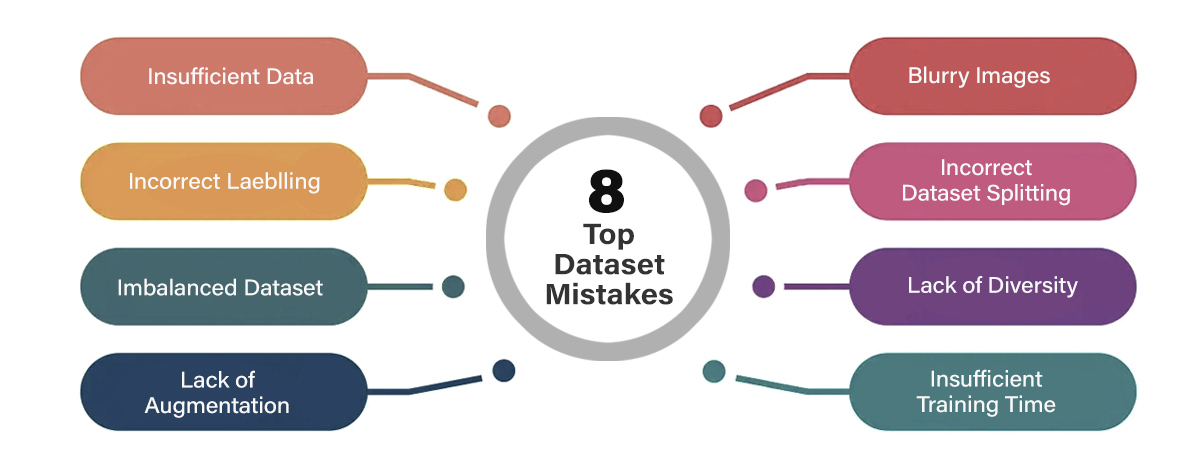April 19, 2023
3 min read
By Cogito Tech LLC.
359 views
Computer vision is a field of artificial intelligence that involves automatic identification, analysis, and interpretation of images or videos. Object detection, in particular, is a critical aspect of computer vision that aims to identify and locate objects from surroundings. With the advancement of deep learning techniques, there has been a significant improvement in the accuracy and efficiency of object detection systems.
However, it is important to note that the performance of an object detection system heavily relies on the quality of the dataset used for training. A high-quality dataset is crucial for achieving accurate and efficient object detection. Therefore, it is essential to avoid mistakes when implementing the best dataset for object detection.
In this article, we will discuss the common mistakes that should be avoided when building a dataset for object detection. These mistakes include insufficient data, incorrect labeling, imbalanced dataset, insufficient augmentation, poor image quality, incorrect dataset splitting, lack of diversity, and insufficient training time. By avoiding these mistakes and building a high-quality dataset, developers can improve the accuracy and efficiency of their object detection systems, leading to better outcomes in various applications.
Insufficient Data
When creating a dataset for object detection, one of the most common mistakes is to use insufficient data. When there is insufficient data, the model is overfitted, in which the model is too closely matched to the training data, and does not generalize well to new images. In order to avoid overfitting, it is imperative that the dataset consists of a variety of scenarios and variations that cover all possible scenarios.
Incorrect Labelling
Labeling accuracy heavily influences the accuracy of an object detection system. False positives and false negatives can result from incorrectly labeled data, reducing the system’s performance. The labeling of the dataset must therefore be accurate and consistent throughout. It is also imperative to label all the objects that are of interest within the image, as leaving out objects may result in the model missing important details and performing poorly.
Imbalanced Dataset
Object classes that are significantly overrepresented or underrepresented in a dataset are referred to as imbalanced datasets. As a result, the model may become biased towards the overrepresented classes and underperform on the underrepresented classes, negatively impacting the performance of the object detection system. The number of samples for each object class must be equal in order to avoid having an imbalanced dataset.
Lack of Augmentation
An enhancement is the process of applying transformations such as rotation, scaling, and flipping to images in order to increase the size and diversity of a dataset. If there is no augmentation, the dataset may be too small and not diverse enough to cover all possible scenarios. In order to increase the size and diversity of the dataset, augmentation techniques must be applied.
Blurry Images
When the image quality is poor, it may be difficult for the model to identify and localize objects within the image, which can negatively affect the performance of the object detection system. As a result, it is imperative that the images in the dataset have high resolution, good lighting, and minimal noise.
Incorrect Dataset Splitting
For an accurate evaluation of the performance of the object detection system, it is essential to separate the dataset into training, validation, and test sets. Nevertheless, an incorrect dataset split may result in overfitting, as the model may become biased towards the training data. It is therefore essential to split the dataset into three equal sets at random and to ensure that each set contains a representative sample of each class of objects.
Lack of Diversity

In the absence of diversity in the dataset, a model may not be able to generalize well if it has not seen enough variation in the data. In order to prevent this from occurring, it is imperative to ensure that the dataset includes all possible scenarios and variations, including different lighting conditions, different object orientations, and different backgrounds.
Insufficient Training Time
Insufficient training time can result in poor performance of an object detection system. In order for the model to be able to generalize well to new images, it must be trained for a sufficient period of time.
Final Thoughts
Object detection is a critical task in computer vision that has various applications in different fields, such as autonomous driving, robotics, and surveillance systems. However, the accuracy and efficiency of object detection systems rely heavily on the quality of the datasets used to train them. Therefore, it is essential to build an accurate and efficient system based on high-quality datasets for object detection.
To create a robust and reliable dataset for object detection, it is necessary to avoid several common mistakes, including insufficient data, incorrect labeling, imbalanced dataset, insufficient augmentation, poor image quality, incorrect dataset splitting, lack of diversity, and insufficient training time. These mistakes can negatively impact the performance of object detection systems and result in inaccurate or inconsistent results.
By taking the time to ensure that the dataset used for object detection is free of these mistakes, developers can improve the performance and reliability of their systems, leading to better outcomes in various applications. The creation of a high-quality dataset is a critical step towards achieving accurate and efficient object detection, and developers must prioritize this step in their development process.
Credit to
Source by [author_name]
Review Website
